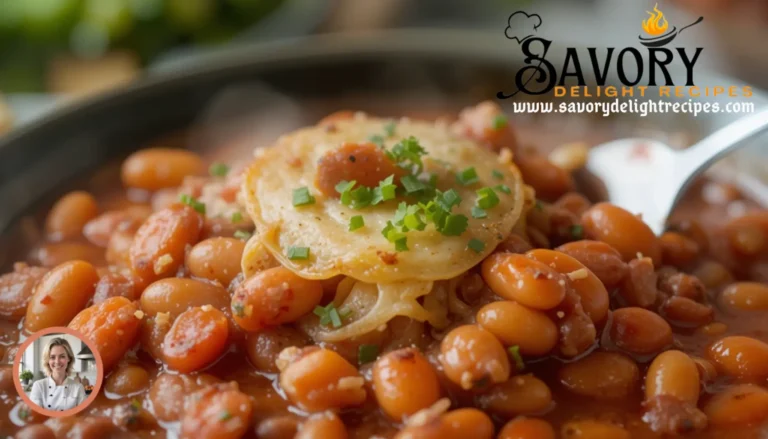Americans spend over $100 yearly on canned baked beans, but these store-bought versions pack preservatives, excess sodium, and artificial flavors that hide the authentic taste of this comfort food classic.
The process of making homemade baked beans isn’t as complex as you might think. A few simple ingredients and techniques can help you create rich, flavorful beans from scratch that will make you forget about store-bought versions.
Your family will love these perfect homemade baked beans. This foolproof recipe shows each step clearly – from selecting the right beans to striking that perfect sweet-and-savory balance that guarantees second helpings.
Essential Ingredients for Perfect Baked Beans
The secret to amazing homemade baked beans lies in picking the right ingredients. Let’s dive into everything that makes your beans taste better than anything you’ll find at the store.
Choosing the Right Beans: Navy vs Great Northern vs Pinto
Your baked beans’ success starts with picking the perfect bean variety. Navy beans are the classic choice that gives you traditional baked beans with their mild, delicate flavor. They hold their shape beautifully through long cooking times. Great Northern beans are a bit bigger than navy beans and give you that same creamy texture. They shine in French-style cassoulets. Pinto beans bring a hearty, earthy flavor that’s perfect when you want a Southwestern kick.
| Bean Type | Characteristics | Best Used For |
|---|---|---|
| Navy | Small, oval-shaped, mild flavor | Traditional baked beans |
| Great Northern | Medium-sized, thin white skin | Creamy, traditional style |
| Pinto | Medium-sized, mottled skin | Southwestern-style dishes |
Sweet and Savory Sauce Components
A signature sauce turns simple beans into something special. Here’s what you need in your base sauce:
- Core ingredients:
- Molasses or maple syrup to add deep sweetness
- Brown sugar for those lovely toffee-like notes
- Mustard (yellow, Dijon, or spicy brown)
- Worcestershire sauce to bring umami depth
- Apple cider vinegar for that perfect tang
Optional Add-ins and Flavor Boosters
You can boost your baked beans with some carefully picked add-ins. Bacon brings that smoky, salty element that pairs perfectly with the sweet sauce. Caramelized onions add depth and natural sweetness. Heat lovers might enjoy chipotle peppers or sriracha sauce that create an exciting flavor dimension.
A dash of liquid smoke gives you that authentic BBQ taste. You might want to try different mustard varieties to find your perfect flavor balance. Orange juice can add natural sweetness while keeping the glycemic index lower – great if you’re watching your sugar intake.
Start with simple flavors and adjust as you go. Adding more seasoning is always easier than fixing over-seasoned beans. The best part about making your own baked beans is that you can tweak them to match your priorities while keeping that classic sweet and savory balance.
Step-by-Step Bean Preparation Method
The perfect homemade baked beans start with properly prepared dried beans. Here’s how to turn those hard beans into tender, tasty morsels ready for baking.
Proper Bean Soaking Techniques
You can choose between two reliable soaking methods. The traditional overnight approach starts with rinsing your beans and picking out any debris. Put them in a large pot with cold water that covers them by about 2 inches. Adding 1 tablespoon of kosher salt per quart of water will give you even cooking and stop the beans from breaking.
The quick-soak method works like this:
- Put beans in a large pot with cold water
- Bring to a full rolling boil
- Cover and remove from heat
- Let stand for 1 hour
Pre-cooking Tips for Tender Beans
Drain and rinse your beans really well after soaking. Add fresh water until it covers them by several inches. You can boost the flavor by adding aromatics:
- Onion and carrot
- Garlic cloves
- Woodsy herbs (rosemary, sage, or thyme)
- Bay leaves
Bring the pot to a gentle simmer. Watch that it doesn’t boil over since beans create foam naturally during cooking. Don’t add acidic ingredients like vinegar or tomatoes at this stage – they’ll prevent your beans from softening properly.
Signs Your Beans Are Ready
Let your beans simmer for about 45-60 minutes. You’ll know they’re perfectly tender by these signs:
Visual Test: The beans’ outer skins should slide back easily when you blow on them Texture Test: They should feel creamy and tender, not mushy Consistency Check: Try several beans since they might cook unevenly
Save the cooking liquid after draining. This starchy water, called aquafaba, helps adjust your sauce’s thickness later.
Make sure your beans are completely tender before you start baking. Expert cooks point out that trying to finish undercooked beans in molasses can make your baking time much longer.
Creating the Signature Sauce
Your exceptional homemade baked beans need a signature sauce that perfectly balances multiple flavor profiles. Let’s become skilled at creating this vital component.
Balancing Sweet and Savory Flavors
A signature sauce needs a careful balance of key ingredients. You’ll need to combine sweet and savory elements in precise proportions:
| Base Ingredient | Recommended Amount | Purpose |
|---|---|---|
| BBQ Sauce | 3/4 cup | Smoky-sweet foundation |
| Molasses | 1/4 cup | Deep earthiness |
| Brown Sugar | 1/3 cup | Mild sweetness |
| Apple Cider Vinegar | 2 tablespoons | Balancing tang |
Incorporating Smoky Elements
The authentic smokehouse flavor comes from combining Worcestershire sauce with your base mixture. This adds a deep umami depth that ties all flavors together. To improve smokiness, to cite an instance, see these options:
- Smoked paprika for subtle heat
- Liquid smoke for intense smokiness
- Dijon mustard for sharp complexity
Adjusting Seasonings to Taste
Your signature sauce development needs customization. Start with the base recipe and adjust according to your priorities. To cite an instance, you can gradually increase brown sugar or maple syrup if you want more sweetness. Extra vinegar or mustard will add more tanginess.
The freedom to tailor flavors makes crafting your own sauce special. Notwithstanding that, make small adjustments and taste as you go. Mix all sauce ingredients in a bowl before adding them to your prepared beans for optimal results.
A vital tip: the sauce should simmer with the beans to let all flavors meld together properly. Taste and adjust seasonings gradually during cooking – adding more is easier than fixing over-seasoned beans.
Note that the sauce will thicken and become glossy and rich during cooking. If your sauce gets too thick, stir in small amounts of the reserved bean cooking liquid until you reach your desired consistency.
Mastering the Cooking Process
You’ve got your beans ready and created the perfect sauce. Let’s look at the cooking methods that will reshape the scene of these ingredients into a mouthwatering dish. Your cooking approach shapes the final texture and flavor depth of your homemade baked beans.
Oven vs Slow Cooker Methods
The oven method stands as the gold standard to make authentic baked beans. Heat your oven to 350°F (175°C). Your oven’s dry heat lets excess liquid evaporate and creates a naturally thickened sauce with that coveted brown crust on top.
| Method | Advantages | Cooking Time |
|---|---|---|
| Oven | Better sauce thickness, brown crust formation | 6-7 hours |
| Slow Cooker | Hands-off cooking, consistent moisture | 6-8 hours on low |
Temperature and Timing Guidelines
Your oven-baked beans need these key steps:
- Start at 350°F for the first hour
- Reduce to 200°F for the remaining cooking time
- Cook covered for first 5 hours
- Uncover for the final hour to achieve desired thickness
Slow cooker users should set their appliance to low for 6-8 hours or high for 3-4 hours. The beans should feel tender and the sauce should coat each bean generously.
Achieving the Perfect Consistency
Perfect baked beans need proper moisture control. Check your beans hourly and add hot water or reserved bean cooking liquid if the top looks dry. Take the cover off during the final hour so excess moisture can evaporate.
Your beans have the right consistency when:
- Sauce coats the back of a spoon
- Beans feel tender yet maintain their shape
- Overall mixture looks thick but not dry
Note that your sauce will thicken as it cools. Add small amounts of hot water if the beans become too dry. If they’re too wet, keep cooking uncovered until you reach the right consistency.
Troubleshooting Common Issues
Making homemade baked beans can challenge even experienced cooks. You can save your dish from disaster and get consistent results by learning to solve common problems.
Fixing Tough or Undercooked Beans
Specific cooking conditions often lead to hard or undercooked beans. Hard water with calcium stops beans from getting soft properly. Here’s how to solve this:
| Problem | Solution | Expected Result |
|---|---|---|
| Hard Water | Use purified water | Faster softening |
| Tough Beans | Add 1 tsp baking soda per cup | Improved softening |
| Uneven Cooking | Maintain slow simmer | Uniform tenderness |
Acidic ingredients make beans taste better but can toughen them if added too soon. Let beans become fully tender before adding tomatoes, vinegar, or molasses. These ingredients make cell walls stronger and slow down cooking.
Adjusting Sauce Thickness
Getting the right sauce consistency needs careful attention. Your sauce might get watery from:
- Too much liquid during cooking
- Not enough reduction time
- Wrong bean-to-liquid ratio
A runny sauce can be fixed by:
- Create a cornstarch slurry (2 tablespoons cornstarch per cup of liquid)
- Simmer for at least 10 minutes after adding the slurry
- Mash 2-3 cups of beans and return to pot
Your sauce might get too thick sometimes. Just add hot water or saved bean cooking liquid bit by bit until it looks right.
Salvaging Oversalted Beans
Oversalted beans can still be saved. These methods help restore balance:
Add Acidic Elements:
- Mix in lemon juice or vinegar
- Start small
- Taste as you go
Sweetener Addition:
- Use brown sugar or maple syrup
- Add little by little to keep flavors balanced
- Orange juice works as a natural option
Tough cases need these advanced fixes:
- Add more unsalted beans to increase volume
- Mix in dairy products like cream or butter
- Add unsalted cooking liquid to dilute
Note that prevention beats fixing problems later. Beans soak up flavors as they cook, so start with less salt and add more as needed. Avoid boiling beans too fast – their skins might split and turn mushy.
Conclusion
Homemade baked beans might seem daunting at first, but this classic dish becomes second nature with practice. Quality ingredients, proper preparation and balanced flavoring will help you create baked beans that taste better than store-bought versions.
Patience plays a vital role in the cooking process. The flavors need time to develop whether you choose traditional oven baking or slow cooker convenience. Your reward will be tender beans in a rich, thick sauce.
Simple adjustments can save your dish if problems arise during preparation. Quality ingredients make a difference, so trust your taste buds while seasoning and adjust cooking times to your needs. Your family will definitely appreciate these homemade baked beans’ authentic taste. The wholesome goodness will make store-bought versions a distant memory.
https://amindfullmom.com/old-fashioned-baked-beans/


1 thought on “How to Make Homemade Baked Beans: A Foolproof Family Recipe (Better Than Canned!)”
Comments are closed.